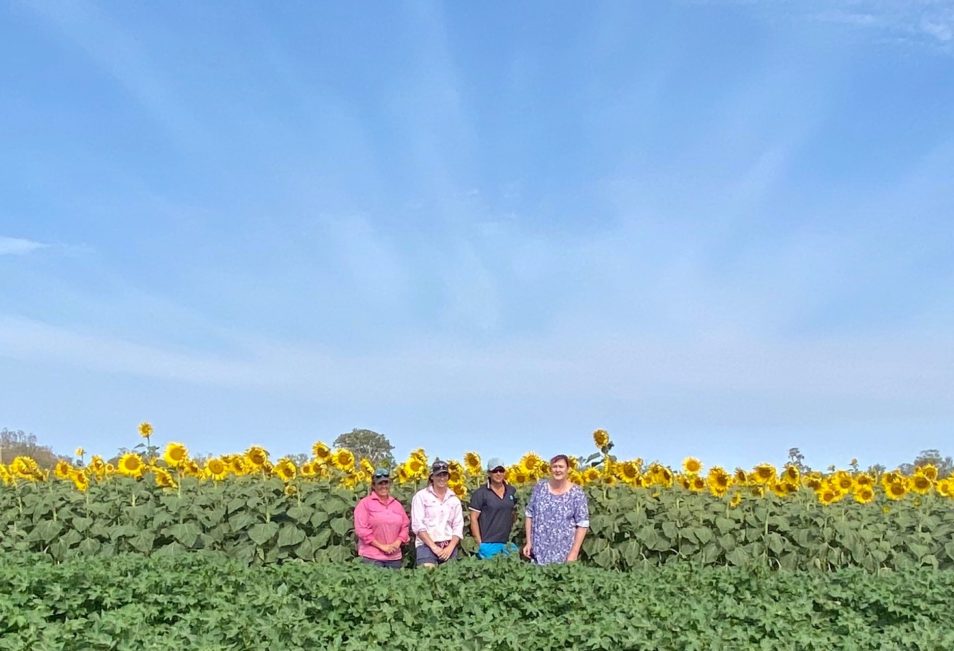
Our researchers Dee Hamilton, Tianne Parker, Ammie Foster and research scientist Simone Heimoana PhD. Image credit: Ali Smith
Big, bright, yellow sunflowers are not just cheery ornamental blooms. We’re using them to research how cotton farmers can use beneficial insects to better control pests and limit their use of harsh insecticides. It’s part of what’s called integrated pest management.
Cotton pests and beneficial insects
Our cotton growers use a range of practices to manage pest and beneficial insects in their crops. Some crops don’t need spraying for pests at all these days. Integrated Pest Management limits disruption to the natural system by reducing chemicals wherever possible. In two five-year periods between 1998-2003 and 2010-2015 insecticide use in Australia fell by 92 per cent because of better insect management.
Cotton crops provide a feeding ground for pest insects like caterpillars, aphids and whiteflies. But they also provide a home for beneficial insects. Several bugs and beetles including spiders, lacewing and hoverfly larvae eat large numbers of pests.
In some cases, pest numbers increase faster than predators can manage them. Cotton growers may need to spray before pests cause economic crop loss. It is best to use an insecticide which does not harm the beneficial insects. Working out the best insecticide draws on over 25 years of experimentation between the sunflowers.
Testing chemicals
Researchers test chemicals at the beginning of summer at the Australian Cotton Research Institute to see how they affect beneficial insects. We separate the experiments with rows of sunflowers. This helps reduce wind and spray drift between plots. For five weeks, we spray the insects weekly. Our team assesses their numbers twice a week. They identify and count around 350,000 insects under the microscope each season. That’s a lot of insects to count!
Regular bug checking – aka pest monitoring – avoids unnecessary spraying. It is also important to know how much damage from insects a plant can tolerate without loss in production or quality. From this information, we can set pest thresholds. To assess these, we need lots of insects in numbers which don’t occur naturally. For this reason, we create pest infestations.
Insects, insects everywhere!
That’s right. We infest a crop with a pest and temporarily reduce the beneficial insects with insecticide. We infest pieces of cotton plants with mites or aphids and place them in the crop. Once they dry up, the insects walk into the crop.
Silverleaf whitefly are fragile, highly mobile and die easily on their way to the field. So, we raise them on crinkly kale pot plants in the glasshouse, then plant them between the cotton plants in the field. As the weather heats up, the kale dies off allowing the Silverleaf whitefly nymphs to mature and get amongst the cotton.
As pest numbers increase, we assess and record their damage to plants. Using data from these trials, we determine how much pest damage cotton can handle.
The natural way of things
Integrated pest management works well for cotton most of the time. Poor weather, too much pesticide and seasonal pest invasions can all cause disruption. Not to mention biosecurity threats. It can also fail if the pests build up resistance to the pesticides.
It is helpful to continue the research even in times of drought. Operating on a limited bore water supply means our team keeps experimental acreage to a minimum. We might also conduct one experiment early in the season, and another later in the season. Experiments we don’t need to carry through to completion, we plough in early to save water.
This research is conducted in partnership with the Cotton Research and Development Corporation and supports the Australian cotton industry.
This article is modified from the original version that appeared in the Narrabri Courier.


17th March 2020 at 12:29 pm
what do the farmers do with the sunflowers
19th March 2020 at 10:15 am
Hi Allan – thanks for your message.
The farmers don’t grow sunflowers unless they decide to grow a sunflower crop. This decision is usually based on costs and prices and the return of cost per hectare. In most cases, the return per hectare is highest for cotton so cotton is the preferential crop to grow if the resources are available.
The scientists only use the sunflowers in our experiments as a means to an end, like windbreaks/spray drift control and shelter for insects. We never harvest any since their field is next to the river and the birds devour the lot. For this reason, we only plant the birdseed variety sunflowers as other varieties can cause feather loss.
However, the scientists do pick some as they tend to start flowering around Christmas. They keep them in a vase.
Hope this answers your question.
Kind regards,
Kashmi
Team CSIRO